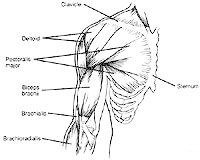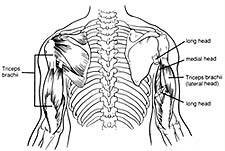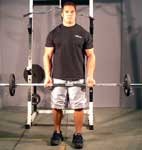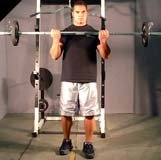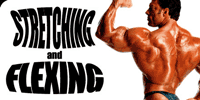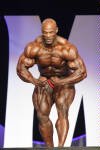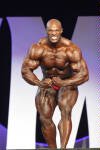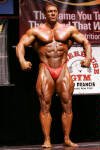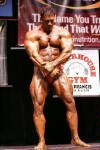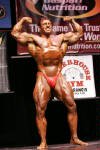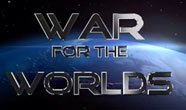
TOPIC: What Is The Most Complete Workout For Building Huge Arms?

The Question:
The arm is one of the most visible body parts. This week's question will focus on a complete arm workout that includes the wrist, forearm, biceps, and triceps.
What is the most complete workout for huge arms? Be specific. Include exercises, sets, reps, etc. for the wrist, forearm, biceps, and triceps.
Would you split some of these up and incorporate with other body parts or would you keep them altogether in one session?
Bonus Question: What Bodybuilder has the most complete package in the arm department?
Show off your knowledge to the world!
The Winners:
- RC26 View Profile
- Aussie LTD View Profile
- bitterplacebo View Profile
- New Prizes:
- 1st place - $75 in store credit.
2nd place - $50 in store credit.
To use your credit, e-mail Will @ will@bodybuilding.com for more info.

1st Place - RC26

The arm is one of the most visible body parts. This week's question will focus on a complete arm workout that includes the wrist, forearm, biceps, and triceps.
Building huge arms is truly outstanding and remarkable. Whether you want to become an IFBB Pro or just walk around in a sleeveless shirt, huge arms are a vital part to your physique. This article will provide you with the most complete training program and all the tips you need to know to build a pair of 20 inch guns.

Workout:
What is the most complete workout for huge arms? Be specific. Include exercises, sets, reps, etc. for the wrist, forearm, biceps, and triceps.
Before getting into the actual workout, there are several things that people need to learn in order to get the most out of their arm training.
 The Anatomy Of The Arms:
The Anatomy Of The Arms:
- Long Head
- Short Head
- Long Head
- Lateral Head
- Medial Head
- Flexor Digitorum Superficialis
- Flexor Digitorum Profundus
- Flexor Carpi Radialis
- Palmaris Longus
- Flexor Pollicis Longus
- Extensor Digitorum
- Extensor Carpi Radialis Longus
- Extensor Carpi Radialis Brevis
- Extensor Carpi Ulnaris
- Extensor Indicis
- Extensor Digiti Minimi
- Extensor Pollicis Longus
- Extensor Pollicis Brevis
The arms are composed of several muscle groups.
Biceps Brachii - A two-headed muscle that curls the arm and supinates the forearm.
Triceps Brachii - A three-headed muscle that straightens the arm and supinates the wrist.
Brachialis - A muscle that lies deep to the biceps brachii and acts to flex the forearm.
Brachioradialis - A muscle located in the upper forearm that acts to flex the forearm.
Wrist Extensors - Composed of many muscles that curl the palm down and forward.
Wrist Flexors - composed of many muscles that curl the knuckles back and up.
Pronator Teres - A muscle located in the forearm that pronates and flexes the forearm.
Anconeus - A small muscle located at the posterior surface of the elbow that stabilizes the elbow joint and assists the triceps in extending the forearm.
For more information on anatomy, visit here.
 The Exercises:
The Exercises:
Biceps:
Standing Barbell Curl
This is the granddaddy of all biceps exercises. When done correctly, this exercise builds the overall size of the biceps. Other muscles involved include the brachialis, brachioradialis, pronator teres, and wrist flexors.
Variations:
Wide-Grip Standing Barbell Curl
Positioning your hands farther apart isolates the short head of the biceps.
Close-Grip Standing Barbell Curl
Positioning your hands closer together isolates the long head of the biceps.
Dumbbell Bicep Curl
This exercise takes the biceps through its full range of motion and is good for symmetry in each arm. Other muscles worked include the brachialis and brachioradialis.
Variations:
Dumbbell Alternate Bicep Curl
This isolates the biceps and allows you to concentrate on one arm at a time. The brachialis and brachioradialis are also involved.
Seated Dumbbell Curl
Using a seated position helps minimize cheating. This exercise primarily works the biceps, along with the brachialis and brachioradialis.
Incline Dumbbell Curl
This exercise stretches the biceps and provides a long range of motion. The brachialis and brachioradialis are worked to lesser degree.
Lying Supine Dumbbell Curl
This exercise provides a great stretch in the biceps through a long range of motion.
Preacher Curl
This is one of the best exercises for working the biceps and minimizing cheating. This is also good for filling the gap between the lower biceps and the elbow joint. The brachialis is also involved.
Variations:
One Arm Dumbbell Preacher Curl
Using dumbbells is good for symmetry and lets each arm work separately. This exercise also works the brachialis.
Machine Preacher Curl
It's almost impossible to cheat while doing this exercise, which in turn can provide a great pump and good biceps development. This movement also works the brachialis, brachioradialis, and pronator teres.
Concentration Curl
This isolation exercise helps create maximum height in the biceps, and also develops the brachialis.
Hammer Curl
This exercise primarily works the biceps brachioradialis, and to a lesser extent, the brachialis.
Overhead Cable Curl
This exercise is usually performed at the end of an arm workout, and is good for stretching the biceps, and working the brachialis.
Triceps:
Lying Triceps Press
This is the best mass building exercise for the triceps, especially when using heavy weights.
Variations:
Decline EZ Bar Tricep Extension
When performed with correct form, this exercise yields big results for your triceps.
Lying Dumbbell Tricep Extension
This movement is good for symmetry and works all three heads of the triceps equally.
Seated Triceps Press
The long head of the triceps is mostly involved when performing this exercise.
Close-Grip Bench Press This exercise builds mass in all three heads of the triceps.
Triceps Pushdown This exercise isolates all three triceps heads and the anconeus.
Variations:
Tricep Pushdown - Rope Attachment
Using a rope primarily works the lateral head of the triceps, along with the long and medial heads. The anconeus is worked to a lesser extent.
Reverse Grip Tricep Pushdown
The under hand grip works the medial head most intensely, with involvement form the long and lateral heads, and anconeus.
Forearms & Wrists:
Palms-Up Barbell Wrist Curl Over A Bench
This exercise works the wrist flexors.
Palms-Down Wrist Curl Over A Bench
This exercise works the wrist extensors.
Wrist Roller
This exercise works the wrist flexors.
Reverse Barbell Curl
This exercise is excellent for strengthening the wrist, and works the wrist extensors, brachioradialis, brachialis, and stretches the biceps.
Compound Exercises:
Barbell Squat
This movement works the quads, adductors, hamstrings, glutes, spinal erectors, and abs. Fifteen percent of upper body growth comes from this exercise.
Barbell Deadlift
A full body exercise that mainly works the traps, quads, glutes, spinal erectors and lower back.
Bent Over Barbell Row
A full back exercise that involves the lats, teres major, traps, rhomboids, rear delts, biceps, brachialis, and brachioradialis.
For more exercises, visit here.
 Training Techniques:
Training Techniques:
Drop Sets - Move immediately from one set to another while decreasing the weight each time, and expect a tremendous pump.
 |
Drop Set Video Guide:
|
Forced Reps - when you reach failure, have a spotter help you force out a couple of reps to push your muscles beyond their limit.
 |
Video Guide:
|
Partial Reps - as soon as you reach failure, continue by doing partial reps until your muscles reach complete failure.
 |
Video Guide:
|
Rest-Pause - when you hit the point of failure, put the weight down and rest for five seconds, then try to crank out a couple more reps.
 |
Video Guide:
|
Supersets - perform two exercises in a row, for example a set of Standing Barbell Curl followed by a set of Lying Triceps Press.
 |
Video Guide:
|
 Stretching:
Stretching:
If you desire huge arms, then you have to stretch before and after each workout session. Stretching helps prevent injury, increase flexibility, and lengthens muscle fibers. Make sure to hold each stretch for at least thirty seconds. Here are good stretching movements for the biceps, triceps, and forearms.
Biceps:
- Doorway Biceps Stretch
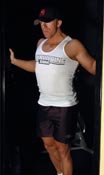
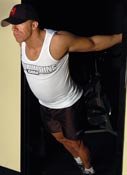
 Click Image To Enlarge.
Click Image To Enlarge. Doorway Biceps Stretch.
Video Guide: Windows Media (225 KB) - MPEG (1.7 MB) - Video iPod (228 KB)
Triceps:
- Overhead Triceps Stretch
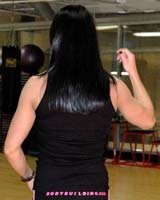
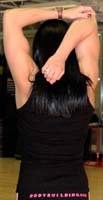
 Click Image To Enlarge.
Click Image To Enlarge. Overhead Triceps Stretch.
Video Guide: Windows Media (185 KB) - MPEG (1.5 MB) - Video iPod (208 KB)
Forearms:
- Single Arm Wrist Flexor Stretch
Single Arm Wrist Extensor Stretch
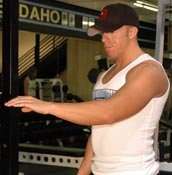
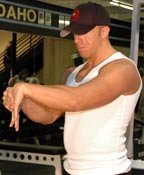
 Click Image To Enlarge.
Click Image To Enlarge. Single Arm Wrist Flexor Stretch.
Video Guide: Windows Media (196 KB) - MPEG (1.4 MB) - Video iPod (199 KB)
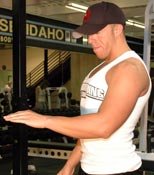
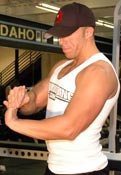
 Click Image To Enlarge.
Click Image To Enlarge. Single Arm Wrist Extensor Stretch.
Video Guide: Windows Media (245 KB) - MPEG (1.7 MB) - Video iPod (233 KB)
For more a full stretching guide, visit here.
 Breathing:
Breathing:
Many people have trouble performing certain exercises, and one of the reasons is not breathing. Never hold your breath when exercising, especially when working with heavy weights. If you have a hard time breathing, force yourself to breathe. For example, when doing Standing Barbell Curl, inhale on the way up, and exhale on the down. If you keep practicing, breathing will become easy to do.
For more on breathing, visit here.
 Flexing:
Flexing:
Flexing helps your muscles fill with blood, which creates a mind blowing pump. After each set, flex your muscles for about thirty seconds, and by the end of your workout, your arms will feel like they will explode.
Flexing should also be used while performing an exercise. For example, when doing Concentration Curl, each time you get to the top of the movement, use the peak contraction principle and flex your bicep as hard as you can for about one to two seconds. This can help increase of the height of the biceps.
For more on flexing, visit here.
| RECOMMENDED ARTICLE | ||
|
 Diet:
Diet:
The single biggest factor that will determine the size of your arms is your diet. If you want to build huge arms, then you better have a good diet.
Calories:
You need a high caloric intake in order to gain size. If you eat 500 more calories than you expend, you gain about 1 pound of bodyweight per week. Eat at least 2500 calories per day, and stay away from junk food.
Protein:
Protein is made up of carbon, hydrogen, oxygen, and nitrogen. Protein builds, repairs, and maintains muscle. Eating at least one gram of protein per pound of bodyweight ensures that your body has all the necessary amino acids, which keep you in an anabolic state.
| PROTEIN CALCULATOR |
- Eggs
- Lean Steak
- Lean Beef
- Chicken
- Turkey
- Fish
- Pork
- Milk
- Cottage Cheese
Good Protein Choices:
Carbs:
Carbs are the body's main supply of energy. A sufficient amount of carbs is needed in order to train with maximum intensity. Eating at least 2 grams of carbs per pound of bodyweight will provide you with enough energy to train like an animal.
| CARB CALCULATOR |
- Pasta
- Oatmeal
- Rice
- Whole Wheat Bread
- Potatoes
- Whey Protein - Optimum 100% Gold Standard
- Casein Protein - Egg Whites International 100% Pure Liquid Egg Whites
- Multivitamin - Universal Animal Pak
Good Carb Choices:
Fats:
Fats are broken down into three groups, saturated, unsaturated, and polyunsaturated. Fats are necessary in a diet, but should be limited. The reason is many foods you eat have hidden fats. For example, if you eat lean steak, you get plenty of protein and at the same time you get some fat. But by all means eat good fats such as omega-3 and omega-6, because they provide support for the body's cardiovascular, reproductive, immune, and nervous systems.
Water:
Muscles are made up of about 75% water by weight, which means the amount of water consumed determines the size of muscles. Water transports nutrients to cells and removes waste-by products. Drinking at least 1 to 2 gallons per day is adequate.
Vitamins & Minerals:
Vitamins are broken down into two categories, water-soluble and fat-soluble. Both are needed by the body for it to function properly.
Minerals are vital substances that the body needs. Examples of minerals include calcium, potassium, and sodium.
Many foods contain vitamins and minerals, but taking a multivitamin is needed in order to get all the necessary vitamins and minerals.
 View Top Selling Multivitamin Products Here.
View Top Selling Multivitamin Products Here.Supplement Recommendations:
wheyFor more information on supplements, visit here.
Creating A Muscle Building Diet:
Eating 4 to 5 small meals daily keeps your metabolism high, and keeps you in an anabolic state. In the morning, opt for some casein protein along with some fibrous carbs. Eat plenty of carbs pre-workout to get energy. After your workout, drink a whey protein shake along with some simple carbs to raise insulin levels and replenish glycogen stores. Before you sleep, drink a casein protein shake to keep you in an anabolic state at night.
 Rest/Recovery:
Rest/Recovery:
Your muscle actually grows when you rest, so don't train on your off days, and limit your physical activities. Sleeping at least eight hours everyday is sufficient. Your body produces growth hormone when you sleep, which helps you recover from your workout sessions.
For more on the importance of sleep, visit here.
Now onto the workout...
 The Split:
The Split:
- Monday - Compound Exercises, Biceps, Forearms
- Tuesday - Compound Exercises, Triceps
- Wednesday - Back or Rest Day
- Thursday - Shoulders and Legs or Rest Day
- Friday - Biceps, Triceps, Forearm
- Saturday - Chest and Abs or Rest Day
- Sunday - Rest Day
 Monday - Compound Exercises, Biceps, Forearms:
Monday - Compound Exercises, Biceps, Forearms:
| Body Part | Exercise | Sets | Reps |
| Compound | Bent Over Barbell Row | 3 | 12, 8, 6 |
| Compound | Barbell Deadlift | 3 | 12, 8, 6 |
| Biceps | Standing Barbell Curl | 3 | 12, 8, 6 |
| Biceps | Dumbbell Bicep Curl | 3 | 12, 8, 6 |
| Biceps | Preacher Curl | 3 | 12, 8, 6 |
| Wrist Flexors | Wrist Roller - Wrist Flexion | 3 | 12 |
| Wrist Extensors | Wrist Roller - Wrist Extension | 3 | 12 |
 Tuesday - Compound Exercises, Triceps:
Tuesday - Compound Exercises, Triceps:
| Body Part | Exercise | Sets | Reps |
| Compound | Barbell Squat | 3 | 12, 8, 6 |
| Triceps | Close-Grip Bench Press | 3 | 12, 8, 6 |
| Triceps | Lying Triceps Press | 3 | 12, 8, 6 |
| Triceps | Triceps Pushdown | 3 | 12, 8, 6 |
 Wednesday - Back Or Rest Day:
Wednesday - Back Or Rest Day:
 Thursday - Shoulders & Legs Or Rest Day:
Thursday - Shoulders & Legs Or Rest Day:
 Friday - Biceps, Triceps, Forearm:
Friday - Biceps, Triceps, Forearm:
| Body Part | Exercise | Sets | Reps | |
| Biceps | Standing Barbell Curl | 3 | 12, 8, 6 | |
| superset with | ||||
| Triceps | Decline EZ Bar Tricep Extension | 3 | 12, 8, 6 | |
| Biceps | Preacher Curl | 3 | 12, 8, 6 | |
| superset with | ||||
| Triceps | Seated Triceps Press | 3 | 12, 8, 6 | |
| Biceps | Concentration Curl | 3 | 12, 8, 6 | |
| superset with | ||||
| Triceps | Reverse Grip Tricep Pushdown | 3 | 12, 8, 6 | |
| Wrist Flexors | Palms-Up Barbell Wrist Curl Over A Bench | 3 | 12 | |
| superset with | ||||
| Wrist Extensors | Palms-Down Wrist Curl Over A Bench | 3 | 12 | |
 Saturday - Chest & Abs Or Rest Day:
Saturday - Chest & Abs Or Rest Day:
 Sunday - Rest Day:
Sunday - Rest Day:

Incorporating With Other Body Parts
Would you split some of these up and incorporate with other body parts or would you keep them altogether in one session?
As you can see in the workout above, biceps, triceps and forearms are trained on similar and different days. I included compound exercises because they develop the entire body including the arms. The rest of the exercises are isolation and they hit a particular area of each muscle in the arms.
Wednesdays, Thursdays, and Saturdays can be either a workout day for the other muscle groups or rest days. It would be a good idea to work those muscle groups so you have a proportioned physique. If you choose to workout your whole body, a good way to avoid overtraining the arms is not doing compound lifts on back, shoulders, legs, and chest days. Use isolation exercises instead. For example, perform Dumbbell Flyes instead of Barbell Bench Press - Medium Grip.
And lastly, I highly recommend that you switch up the exercises every couple of weeks, while also incorporating the training techniques to shock your muscles into accelerated growth. The exercises and training techniques are all located at the top of this article.

Bonus Quetion:
What Bodybuilder has the most complete package in the arm department?
Ronnie Coleman, eight-time Mr. Olympia, has the most complete package in the arm department. His arms are one of the reasons he's won so many times. He has 22 inch arms, and you can clearly see the separation between his biceps, triceps, and forearms. Each muscle in his arms is fully developed and defined. Not only that, but his arms are very powerful.
I hope you have enjoyed this article and I encourage you to follow this program. Good luck!
References:
- https://www.bodybuilding.com/fun/anatomy.htm
- https://www.bodybuilding.com/fun/exercises.htm
- https://www.bodybuilding.com/fun/stretches.htm
- https://www.bodybuilding.com/fun/ice21.htm
- https://www.teenbodybuilding.com/mclane11.htm
- https://www.bodybuilding.com/store/index.html
- https://www.bodybuilding.com/fun/drobson5.htm
- The New Encyclopedia of Modern Bodybuilding by Arnold Schwarzenegger, Bill Dobbins

2nd Place - Aussie LTD
What is the most complete arm workout? 
There are many arm workouts out there and although many may be very effective, very few I've seen have included exercises that target every part of the arm.
Many stick to the basics, and end up with basic arms, but if you want the best development, you need a program that is designed down to a tee. In this article I will provide several different detailed programs for complete arms, and discuss possible splits. Read on, and turn those long sticks into big bricks.

Workout:
What is the most complete workout for huge arms? Be specific. Include exercises, sets, reps, etc. for the wrist, forearm, biceps, and triceps.
We want total arm development, so that means training more than just the biceps and triceps. The arm also has the forgotten muscles such as the brachialis and the brachioradialis as well as the forearm flexors and extensors, all of which will add aesthetical appeal to the arm when developed.
Let's take a little look at each muscle, and how they contribute to full development.
 The Bicep Brachii:
The Bicep Brachii:
Although most of us are well informed on the structure of the bicep, for those that aren't, here are the basics: The biceps consist of the short head, the long head and the brachialis.
The short head, or inner region, is hit with movements where the elbow begins behind the body such as incline curls or when you adopt a closer grip on barbell curls, whereas the long head is emphasized on movements where the elbow begins in front of the body such as preacher curls, or when you adopt a wider grip on curling movements.
Overall, hitting each area is vital for overall development; the long-head, the short-head as well as the brachialis, which I'll discuss later, all help create the shape that will give them the impressive look we are striving for.
 Triceps:
Triceps:
The triceps consist of 2/3 of the overall upper arm, so don't think you have any chance of getting 20 inch gun by focusing primarily on biceps.
The triceps consist of three heads. First is the long head, which is the meat of the tricep and is visible when doing a front bicep pose. Lying behind the longhead, just near the elbow, is the smallest of the 3 heads. This is a neglected muscle that when developed, will enhance the whole look of the arm.
Then there is the lateral head. This is the muscle responsible for creating that horseshoe shape we all want. Take a look at pics of either Phil Heath or Shawn Ray to see what I'm talking about. The muscle adds aesthetical appeal while adding mass to the triceps.
How do you train each area? Firstly to hit the lateral head, use a hammer grip on extensions. This shifts the tension from the bulk of the tricep. Some good examples include cable top pushdowns, dumbbell overhead extensions and leaning cable tricep extensions.
To hit the small head, use a reverse-grip. Good exercises here are reverse-grip cable kickbacks, reverse-grip pushdowns and reverse-grip EZ bar lying tricep extensions. And finally a palms grip will tend to hit the meat of the tricep, the long head.
Overall, by developing triceps, you are bulking up 2/3 of your arms, and putting yourself on target of your goal of massive guns.
 The Brachialis: The Forgotten Aspect Of The Biceps:
The Brachialis: The Forgotten Aspect Of The Biceps:
For a long time, this muscle was overlooked when it came to overall arm development, but people are starting to realize its importance.
The brachialis is located on the lower insertion point of the bicep brachii and as a result, it can either make your bicep begin from elbow joint, giving your bicep a 3D look, or make the whole bicep appear flat.
Exercises in which the hand is positioned in front of the body, such preacher curls, or concentration curls hit the brachialis.
 The Forearms:
The Forearms:
The forearms are also often overlooked when it comes to developing arms. Many believe that heavy compounds will do the job, but if you want those thick, shapely forearms that compliment the upper arm, forearms need to be isolated. The brachiradialis is the first part we'll take a look at.
The Brachioradialis:
Some people have never even heard of this muscle. It extends from the wrist to past the elbow joint, and then inserts between the bicep and tricep. When developed, it adds a nice shapely look to the arm, as well as the illusion of width, which both make the arm appear bigger and more aesthetic.
To hit this muscle, it is believed using a reverse-grip on any curling movement will work, especially when you extend your wrists upwards during a movement. Good examples include; Reverse-grip EZ bar curls, Reverse-grip EZ bar cable curls, Reverse-grip EZ bar preacher curls.
This leaves us with the rest of the forearm. Although the whole forearm is composed of many smaller flexors and extensors, overall they are split into two areas; the wrist flexors and the wrist extensors.
Wrist Flexors:
These are located on the inner forearm, and as they are stronger they therefore have the potential for more growth. Think of these as the forearms bicep; they're role is to curl the wrist in.
When developed, this muscle adds bulk to the forearm, and if trained from the right angles you can develop a peak at the top of the forearm. Take a look at Lee Priests forearms to see what I mean. You can work forearms by using any form of wrist curls: dumbbells, barbell or cables.
The Wrist Extensors:
These compose of the other half of all the forearm muscles. The extensors move the forearm up, and are located on the outer part of the forearm.
Generally, they are a weaker muscle, and have less potential to grow compared to the flexors. But when they are isolated, you can develop razor sharp striations that add an aesthetic look to the whole arm.
The wrist extensors can be trained the opposite way of training the flexors; by extending the lower arm upwards using either cables, dumbbells or barbells. I prefer doing wrist extensions with cables and dumbbells over barbells as keeping your grip isn't such as problem, and as a result it isolates the muscle more, you can add more weight and it feels smoother.
 |
Tip: Many people don't release that the angle your arm is at can shift the tension to either the upper or lower part of the forearm. Do like I do, and if your doing 3 sets of an exercise, perform one set on a flat bench, one on incline, and one of decline to isolate each area. |
 |
 |
||
 And Don't Forget The Wrists:
And Don't Forget The Wrists:
Although exercises for the forearms are known as "wrist" curls/extensors, they actually train the forearms. To shift the tension to the wrist, you do forearm extensions/curls on a decline.
The rule is: the lower the decline, the lower on the arm will be hit. These can either be performed on a decline bench, or by heightening a flat bench by using a block under one side.
Alternatively, you can the barbell or dumbbell into the fingers when doing wrist curls. Many people don't realize that this actually that this trains the wrists.
Keep in mind that the wrists are only a small muscle group, and like all small muscles, they don't need as much volume. Overdeveloped wrists aren't always most desirable as they can make your upper arms look smaller. I recommend doing just 1-2 intense sets for wrists for wrist development.

The Routines
 3-Day Split:
3-Day Split:
- Delts: 9
- Biceps: 6
- Triceps: 6
- Forearms: 4
- 8-10 repetitions for all exercises.
- During Supersets: No rest
- Unilateral Exercises: No rest
- After Supersets and between Delt Straight sets: 45 seconds - 1 minute
Overall Split:
Monday: Chest/Back/Abs
Wednesday: Quads/Hams/Calves
Friday: Delts with Biceps/Triceps/Forearms
Volume - 25 sets:
Repetitions:
Rest:
Workout:
(Delt) 2 sets: Seated Overhead dumbbell presses
2 Supersets:
Lying tricep extensions: Flat and Decline
Seated Dumbbell Curls
(Delt) 2 sets: Dumbbell Side-laterals
2 Supersets:
Overhead Dumbbell Extensions
Incline Curls
(Delt) 2 sets: Machine Overhead Presses
1 superset:
Reverse-grip Tricep Pressdowns
EZ bar Preacher Curls
(Delt) 2 sets: Bent-over Cable Lateral Raises
1 superset:
Reverse-grip Cable Kickbacks
Concentration Curls
(Delt) Upright Rows - 1 set
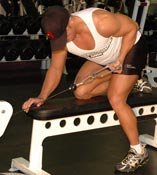
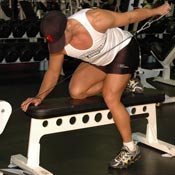
 Click Image To Enlarge.
Click Image To Enlarge. Reverse-Grip Cable Kickbacks.
Video Guide: Windows Media (435 KB) - MPEG (3 MB) - Video iPod (400 KB)
 4-Day Split:
4-Day Split:
- Biceps: 7
- Triceps 7
- Forearms: 3
- 8-10 repetitions for all exercises.
- 45 seconds - 1 minute between all exercises
- 2 sets: Lying Tricep Extensions - Flat/Decline
- 2 sets: V-bar Tricep Pressdowns
- 2 sets: Overhead One-arm Dumbbell Extensions
- 1 set: Reverse-grip Cable Kickbacks
- 1 set: Dumbbell Wrist Curls
- 1 set: Dumbbell Wrist Curls with Wrist Roll
- 1 set: Dumbbell Wrist Extensions
- 2 sets: Seated Dumbbell Curls
- 2 sets: Incline Curls
- 2 sets: EZ-bar Preacher Curls
- 1 set: Cable Rope Curls
You have several options training on a four day split. One option is to train biceps/triceps/forearms on their own day. In this case, follow the routine outlined in the 5-day split section following.
Another option is to train arms with delts. In this case, you can apply the routine above in the 3-day split. Either routine fits nicely into their respective 4 day splits.
However, some may want to stick to the basic chest/tri and back/bi split, so here is another option:
Traditional 4-Day Split:
Monday: Chest/Triceps
Tuesday: Back/Biceps
Wednesday: Quads/Hams
Thursday: Off
Friday: Delts with Traps and Calves
Volume:
Repetitions:
Rest:
Workout A: Chest With Triceps & Forearms:
Chest: 12 sets
Triceps: 7 sets
Forearms: 3 sets
Tricep/Forearm Routine Completed After Chest Routine
Triceps:
Forearms:
Workout B: Back With Biceps:
Back: 15 sets
Biceps: 7 sets
Bicep Routine Completed After Back:
Biceps:
 5-Day Split:
5-Day Split:
All 5 day split train biceps/triceps/forearms on the same day. Here is a good routine:
Volume: 24 sets: Biceps: 10 Triceps 10 Forearms: 4
Repetitions: 8-10 repetitions for all exercises.
Rest: During Supersets: No rest Unilateral Exercises: No rest After Supersets: 45 seconds - 1 minute
The Workout:
3 Supersets:
EZ bar Lying tricep extensions: 3 sets: flat, decline, incline.
With:
EZ-bar Curls: 1 set
Close-Grip Barbell Curls: 1 set
Alternating Bicep Curls: 1 set
2 Supersets:
Preacher Curls
Tricep Pressdowns V-bar
2 Supersets:
Incline Curls
Cable Extensions
2 Superset:
Overhead Two-arm Dumbbell Extensions
Concentration Curls: 1 set
1 Superset:
Cable Rope Curls
Cable Kickbacks Reverse Grip
2 Supersets:
Dumbbell Wrist Curls with - 2 sets, flat with wrist roll and 20 degree incline
Dumbbell Wrist Extensions - 2 sets, flat, and 20 degree incline

Incorporating Other Body Parts:
Would you split some of these up and incorporate with other body parts or would you keep them altogether in one session?
If we are on a 5 day split, or possibly a 4 day split, then yes. Considering we are paying particular attention to developing the most complete arms we can, then training them altogether on the one day is the best option as we are able to give them the attention they need.
In most other splits, biceps have to be trained after a strenuous heavy back session, and triceps after chest, where heavy compound lifting leaves you with very little potential to train biceps and triceps to their fullest.
Additionally, by training them all at once you are increasing stress, lactic acid and blood flow to the whole arm at the one time, and as a result, you are able to intensify both the pump and burn. This will not only blow them up like bubbles, but will have a massive impact on growth.
You are also able to use techniques such as supersets more effectively as opposed to training arms following a bigger muscle. Because you are supersetting opposing muscles, there is minimal negative impact on the intensity of the following set, and as a result you are able to train quicker without sacrificing weight.
On a final note, training biceps, triceps and forearms together encourages arm symmetry. To a lot of us it comes as second nature to over emphasize on training biceps, even if we tell ourselves not to. But because your alternating exercises on arm day, you are more likely to have equal volume for both biceps and triceps, while also less likely to ignore the forearms. How often do you skimp on forearms after a heavy chest or back session?
Overall, your 5 day split would look something like this:
- Back/Abs/Chest
- Legs
- Biceps/Triceps/Forearms
- Off
- Delts/Traps
As you can see, on a 5-day split arms fit nicely. However, there are a few circumstances in which it may not work this well. One of these is when you're on a 3 day split. You have to keep in mind that your main goal with arm training should be to train arms with a volume that is in accordance with other bigger muscle groups. Because biceps/triceps/forearms are smaller, they only need half the volume of a bigger muscle group.
As a result, on a 3 day split, training arms all on one day would throw off the balance too much of your other body parts and also quickly lead to arm overtraining.
Therefore, on a 3 day split, it's an idea to train biceps/triceps/forearms with delts. This way, even though they aren't given their own day, they also aren't thrown behind another major muscle group. Each major muscle group; legs, arms and chest/back have their own day to focus on; by doing this, all opposing muscles are trained together and increase the pump.
A 4 day split is a little different however. Here you are able to train biceps/triceps/forearms their own day, but if you do so, delts will be put in a comprising position. As a result, you may still have to train delts with arms in this situation. Here are two 4 day splits - one where arms are alone, and the other delts with arms:
Arms On Their Own Day:
- Back/Traps/Calves
- Chest/Delts
- Off
- Quads/Hams
- Biceps/Triceps/Forearms
Delts With Arms:
- Back/Traps
- Chest/Forearms/Abs
- Off
- Quads/Hams/Calves
- Delts/Biceps/Triceps/Forearms
Others may even find it OK to stick to a more traditional split where biceps are trained with back, and triceps are trained with either chest. There are many options available for 4 day splits.
From my own experience, I prefer training opposing muscle groups together. But like all training, give whatever you try at least 8 weeks before making any judgment, and see which feels better.

Bonus Question:
What Bodybuilder has the most complete package in the arm department?
There are many pro's with exceptional arm development; from Arnie to Dexter to Levrone, and even rookies such as Phil and David Henry. I'll go over a few of my favorites in this area:
 Today's Pro's:
Today's Pro's:
Lee Priest:
When you think arms, most people think Lee Priest. His arms are massive; like bubbles; yet he is able to maintain proportion between his biceps, triceps and forearms.
Dexter Jackson:
Dexter Jackson is another pro with amazing arm development. They aren't the size of Priests, but they have nice, carved in detail and flawless symmetry.
Phil Heath:
Like Dexter, Heath is another with a very aesthetical pair of arms. Look at his triceps in the side-tri pose: many says his arms match those of Shawn Ray's.
Taylor:
Taylor's arms are definitely his best body-part. They are simply massive.
Darrem Charles and David Henry are two others that come to mind. Both are known for having shredded, massive guns that never fail to impress the judges.
 Past Pro's:
Past Pro's:
In the past, arms were just as important, if not more so. Here are some of my favorites from yesteryear.
Kevin Levrone:
Even though he has just retired, this guy had one of the biggest, and aesthetical delt/arms in bodybuilding history. They were simply amazing!
Arnie:
Need I say more? Arnie had the best bicep peak in history, and set the standard for size for future bodybuilders.
Larry Scott:
This guy's arms were blown up like bubbles. He was the Lee Preist of the 60's.
I know there are many others who had impressive development in the arm area, but these guys above did a pretty good job for setting the standard. Overall, bodybuilders like Dextor Jackson, Phil Heath, Darrem Charles and David Henry don't only carry 20 + inch guns, but do pride on creating aesthetical, well-shaped physiques.
Arms are no exception: in your own training, make sure you are hitting each area of your arms hard, including all heads of the biceps and triceps, the brac and brachialis as well as the forearms. Use at least one exercise for each area, train to failure, and those massive (and symmetrical) guns you've always wanted will be yours!
Good luck with your arm training.

3rd Place - bitterplacebo
What Is The Most Complete Workout For Building Huge Arms? 
They're often the first thing we flex when we're asked. As one of the most easily seen body parts in the mirror and others' eyes, they can end up reflecting our strength and fitness more heavily than other body parts. Besides these points, nothing is more impressive than toting arms as big as some people's legs.
While building bigger arms is a goal of many, it's a daunting task when one lacks proper planning and knowledge of arm anatomy. In order to get the largest arms possible, we'll look individually at how to stimulate each and every muscle in the arm for maximum growth.
Not only will we analyze the biceps, triceps, and forearms, we'll see how to craft bigger, stronger hands and shoulders. As the muscle that connects the arms to the torso, it's important not to overlook the deltoids when training for bigger arms. Each of the mentioned muscle groups deserves separate and specific attention to achieve the most complete work out for massive arms.

Workout:
What is the most complete workout for huge arms? Be specific. Include exercises, sets, reps, etc. for the wrist, forearm, biceps, and triceps.
First, the exercises will be revealed in some suggested and comprehensive workouts. Then, each exercise will be discussed to clarify its role in developing a complete arm. Because of the number of different exercises needed to achieve this completeness, several workouts are organized to keep intensity specific. The point of this is to obtain maximum growth stimulus throughout the arm.
The workouts are arranged as follows:
All rest periods between sets should be kept between 1-2 minutes.
 Biceps/Triceps Workout:
Biceps/Triceps Workout:
- Hammer Curls 2 sets 8-12 reps
- Seated Triceps Press 2 sets 8-12 reps
- Close-Grip Standing Barbell Curl 2 sets 8-12 reps
- Tricep Dumbbell Kickback 2 sets 8-12 reps
- Wide Grip Standing Barbell Curl 2 sets 8-12 reps
- Reverse Grip Tricep Pushdown 2 sets 8-12 reps
- Reverse Barbell Curl 2 sets 8-12 reps
- Triceps Pushdown 2 sets 8-12 reps
- Standing One-Arm Cable Curl 2 sets 8-12 reps
- Cable One Arm Tricep Extension 2 sets 8-12 reps
 Forearm Workout:
Forearm Workout:
- Palms-Down Wrist Curl Over A Bench 3 sets 8-15 reps
- Palms-Up Barbell Wrist Curl Over A Bench 3 sets 8-15 reps
- Standing Palms-Up Barbell Behind The Back Wrist Curl 3 sets 8-15 reps
 Hands/Grip Strength Workout:
Hands/Grip Strength Workout:
- Hand Gripper 3 sets 1-5 reps
- Finish with a set of 4 negatives with a gripper that cannot be closed once single-handed
 Click Here For A Printable Log Of Hands/Grip Strength Workout.
Click Here For A Printable Log Of Hands/Grip Strength Workout.
 Hands/Grip Endurance Workout:
Hands/Grip Endurance Workout:
- Hand Gripper 3 sets 15+ reps
- Finish by holding the gripper closed as long as possible
 Click Here For A Printable Log Of Hands/Grip Endurance Workout.
Click Here For A Printable Log Of Hands/Grip Endurance Workout.
 Shoulders:
Shoulders:
- Seated Barbell Military Press 2 sets 8-12 reps
- Standing Dumbbell Upright Row 2 sets 8-12 reps
- Front Dumbbell Raise 2 sets 8-12 reps
- Seated Side Lateral Raise 2 sets 8-12 reps
- Lying Rear Delt Raise 2 sets 8-12 reps

Exercises
Executing the exercises as outlines will synergistically work to build anyone a set of arms that they can be proud of. An example training split for the full body can be found later, but we should first analyze each exercise from an anatomical standpoint to see its role in arm development.
 Biceps Exercises:
Biceps Exercises:
- Hammer Curls - Adds additional emphasis on the brachioradialis, a muscle on the front of the forearm.
- Reverse Curls - Works the brachialis, a muscle that actually goes beneath the biceps and can push it higher when flexed.
- Wide Grip Curls - An exercise that stimulates more of the inner, or short head of the biceps.
- Close Grip Curls - The outer, or long head of the biceps is the target with this one.
- Any Single Arm Cable Curls - Allows for constant tension and maximum concentration on contractions for building larger "peaks" in the biceps.
 Triceps Exercises:
Triceps Exercises:
- Overhead Tricep Press - The long head of the triceps is fully stretched and contracts stronger with this exercise. This long head is located on the back, inner part of the upper arm.
- Palms-Down Pushdown - The first and strongest part of the triceps to contract in this movement is the medial head, or lower, inner side of the back, upper arm.
- Palms-Up Pushdown - With this exercise, the outer side of the upper arm, or lateral head of the triceps, is worked more intensely.
- Tricep Kickback - Targets both the medial and lateral heads of the triceps.
 Forearm Exercises:
Forearm Exercises:
- Palms-Down Wrist Curl - A full stretch and contraction and be obtained in the inner forearms.
- Palms-Up Wrist Curl - Works the upper forearms.
- Behind the Back Wrist Curl - Again, the inner forearms are extended and contracted in this movement.
 Hand/Grip Exercises:
Hand/Grip Exercises:
-
Fully closing hand grippers uses most of the muscles of the hands and forearms.
 Shoulder Exercises:
Shoulder Exercises:
- Military Press - This compound movement involves the anterior, or front, deltoid as the primary mover.
- Upright Row - Also a compound exercise, but stimulates the side of the shoulder, or lateral deltoid.
- Front Raise - Targets the anterior deltoid, where the arm connects to the chest.
- Side Lateral Raise - Works the side of the shoulder, where the arm meets to the collar.
- Rear Delt Raise - The posterior, or rear, deltoid contracts. This is where the arm joins with the back.
These exercises and workouts should be thought of only as a good basis for building arm mass. In reality, growing muscles is a lot more than just training at a gym. It is a whole lifestyle of properly planned nutrition and recovery.
From a nutritional view point, gaining muscle mass requires eating more. If a person is maintaining their weight on a certain diet, they should not expect to gain significant mass while training on the same diet. In order to create something that was not there before, we need to eat more of what was not there before. But do not mistake all foods for being equal.
Make sure to eat more clean protein and complex carbohydrates rather than simple sugars and fat. This will mean the difference between gaining fat and gaining muscle.
Because we know muscles grow in the time outside of the gym, it's important that we make this time as beneficial and supportive of that growth as we can. The basis of recovery lies in the diet as we already covered, but also in getting enough sleep at night. It would be a good idea for anyone trying to gain mass to sleep at least 8 hours a day.
In addition, other techniques can be used to enhance recovery from those intense workouts. Some examples of such techniques are post-workout nutrition, massages, stress reducing activities, stretching, or contrast baths. When money is not an issue, supplementation can also be used to aid recovery. Protein powders, multivitamins, creatine, nitric oxide, amino acids, and natural testosterone boosters would all be good supplements to look into.
By adopting the training, nutrition, and recovery methods that were introduced above, we can create an environment conducive to muscle growth. The rest of the story is just sticking with the plan to put in the time and effort.

Incorporating Othe Body Parts:
Would you split some of these up and incorporate with other body parts or would you keep them altogether in one session?
These workouts are comprehensive enough to be done on a weekly rotation in order to build massive arms. In order to concentrate on growing the arm muscles, it's necessary to train them together in groupings that can push them to their maximum intensity. The workouts suggested above accomplish this and are good examples to use. However, it's important to not neglect other parts of the body besides arms.
Training other large muscles in the chest, back, and legs can have an indirect effect on arm size and growth. Simply by training these other areas, the body will be forced to new levels and compensate slightly in allowing the arms to grow larger. In addition to this indirect effect, the arm muscles are also used to a minor degree as secondary and stabilizing muscles during compound exercises. In a sense, it's like training them again in a different manner.
Because we want the best and most complete arm development, we need a training split that will work the arm muscles both directly and indirectly. The following sample 5-day split accomplishes this through two training sessions a day.
- Day 1: Biceps/Triceps workout, then later the Forearm workout
- Day 2: Leg workout, then later an optional Abdominal workout
- Day 3: Chest workout, then later the Gripping Endurance workout
- Day 4: Back workout, then later an optional Abdominal workout
- Day 5: Shoulder workout, then later the Gripping Strength workout
- Day 6: Off
- Day 7: Off
This plan works the major arm muscles directly and intensely, giving them a full recovery day before indirectly using them in the chest and back workouts. Finally, the last day devotes a workout to the shoulders, while the forearms and hands are actively involved throughout the week to keep them strong and growing. Overall, going through the whole deal with intensity will keep the arms growing to sizes that they deserve to be.

Bonus Question:
What Bodybuilder has the most complete package in the arm department?
Assembling the knowledge and putting together the complete plan for complete arms are only the first and easiest steps. The rest of the process makes use of our knowledge by properly and consistently executing the plan with intensity. One bodybuilder who exemplifies the whole deal is Bob Cicherillo.
By demonstrating not only the knowledge for building complete arm physiques, but also the arms themselves, Bob definitely has the whole package. As the recent winner of the 2006 IFBB Masters Professional World Championships, Bob documented his triumph in a series of videos called "War for the Worlds."
| RELATED SECTION | ||
|
Here, he provides inspiration to all by displaying not only his impressive arms and overall physique, but also his interesting bodybuilding knowledge and personality.
So now we have the real life inspiration proving that complete and massive arms are possible. We also have the training and lifestyle planned out to achieve such arms. There's nothing left but to go out and get them for yourself.
References:



